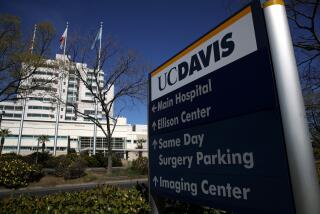Op-Ed: Measles is back: a mother’s warning
I know that parents worry about whether vaccines are safe for their children. But they should also consider the dangers of not vaccinating, which is why I’m telling my family’s story.
In 1970, on a Fulbright cultural exchange, my husband and I moved to the Midlands of England with our 5-year-old daughter and 10-month-old son. Our daughter had received all her vaccinations, but our son was too young for his measles shot when we left home. Our pediatrician wasn’t worried. “Just get it there in a few months,” he said.
But when we asked about the inoculation after our arrival, the English pediatrician said, “We don’t do those.”
A few months into our stay, when our son was 13 months old, he and his sister were playing at a friend’s house. Mothers and kids were talking and laughing when the host boy, Ian, gave an enormous sneeze, and our toddler marched right through the cloud.
Three days later, Ian’s mother called. “He has the measles.”
An epidemic was sweeping England. Our son soon developed a fever so high that his torso was too hot to touch even to comfort him, while his extremities were cold, and he had purple fingernails and toenails. Light hurt his eyes, so we blocked the window with cardboard. The doctor came to see him and said words we will never forget: “If he lives through the night.”
He did live through the night. I kept a log of his temperature, the changing color of his face and nails and how long he slept. I noted every drop of liquid or nourishment he took. And slowly our strong, brave boy recovered.
Two months later, he was still tired, but he was able to walk and talk and smile again. He finally seemed OK. And then he didn’t. One day, excited to see his Daddy’s car pull into the driveway after work, he had a convulsion.
Wonderful neighbors saw us carrying a limp toddler to our car. One took our daughter home with her; another drove us from hospital to hospital, to find a pediatric ER. In the back seat, our son lay on my lap. Quietly, he stopped breathing and turned blue. “He’s died,” I told my husband and the driver. But as we were figuring out what to do, he started breathing again and gradually regained his color.
At the pediatric hospital, he was put in the encephalitis ward, with children in a vegetative state, being fed by stomach tube. No one would give us a diagnosis. But the meds were specific. Our son was the only child in the ward able to talk. He kept checking what everything was. He’d point and ask, “Dat’s a?” We’d say, “That’s your bed. “ “That’s a clock.” “That’s your foot.” We went home at night to sleep, rushed back each morning.
It was months before we got a diagnosis: He had measles encephalitis, a complication that affects about 1 in 1,000 children who get measles. I was familiar with the condition. Growing up, I had dear family friends whose son had contracted it at age 3 and grown into a tall, handsome boy with the mind of a preschooler afraid of strangers. He’s still alive, in a group home in Oregon.
When our son came home from the hospital, he’d lost the ability to regulate his body temperature, and if he got too hot, he’d convulse. I checked him every 20 minutes all day and even at night. He couldn’t take a nap without a convulsion unless I lifted his sheet and fanned him when his cheeks got pink. He couldn’t ride in the back seat in our car because the air circulation wasn’t good enough.
It took a year of hyper-vigilance.
When we returned to the United States, our San Diego pediatrician told us we were lucky that the encephalitis had attacked his whole brain rather than settling in one section. That’s why he recovered.
We had another few years of slipping off his shirt and shoes and socks when he got sweaty, but our tough, strong, smart baby grew into a determined, talented boy. We know how incredibly lucky we are — how it could have ended.
It’s highly likely that the few doctors fueling the anti-vaccine movement — bucking the vast majority of their peers — have never seen a case of measles encephalitis. They haven’t had to, thanks to those who vaccinate. But do parents who choose not to vaccinate understand that they may be giving deadly diseases the chance to regain footholds? And it won’t just be their children who pay the price. In epidemics, even vaccinated children can fall ill. And outbreaks give bacteria and viruses the chance to evolve to beat vaccines and treatments.
In the first eight months of this year, there were 18 measles outbreaks in the United States and nearly 600 cases of measles. That’s nearly three times more cases than in any year since 2001, according to statistics kept by the Centers for Disease Control and Prevention.
When I read about a child fighting measles here — where we once were safe — I feel that heartbreaking weight of a beautiful brown-eyed toddler not breathing, blue, on my lap.
Margaret Harmon’s latest book is “The Genie Who Had Wishes of His Own: 21st Century Fables.”
Follow the Opinion section on Twitter @latimesopinion
More to Read
Start your day right
Sign up for Essential California for news, features and recommendations from the L.A. Times and beyond in your inbox six days a week.
You may occasionally receive promotional content from the Los Angeles Times.






